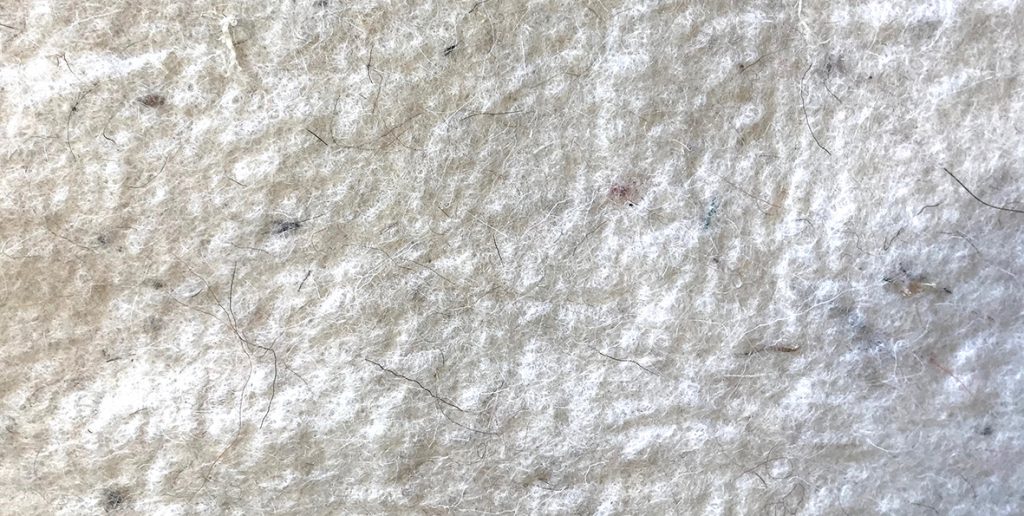Kaart 3. – vilt for English see below
Schapenwol wordt tot vilt verwerkt. Vilt wordt gebruikt om winddichte en waterafstotende yurts te maken en warme kleding en laarzen voor de lange, ijskoude winters. Vilt dient ook ter bescherming van neus en mond tijdens zand- en sneeuwstormen. De doden worden in vilt gewikkeld en begraven. De wol van de schapen is moeilijk te verkopen, de prijzen zijn te laag. Iedereen gebruikt Chinees textiel.
Vilt is geen weefsel van ketting- en inslagdraden maar een verdichting en verstrengeling van vezels, niet homogeen maar wel glad; het heeft geen centrum en geen duidelijke boven- en onderkant. De nomaden gebruiken het zowel voor tenten als voor kleding. Zoals de punten ondergeschikt zijn aan het traject van de nomaden, is ook hun verblijfruimte ondergeschikt aan de reis en voegt de binnenruimte zich naar de buitenvorm zoals bij een tent, een iglo en een boot. (uit: Félix Guattari en Gilles Deleuze, A Thousand Plateaus, Capitalism and Schizophrenia, hoofdstuk 14, 1440 The Smooth and the Striated).
De opening van de yurt moet altijd naar het zuidoosten gericht zijn, naar de zonsopgang. Bij het naar binnen (en naar buiten) gaan moet je bukken om de lage toegang te passeren en uit respect. De paal (bakan) naast de yurt staat voor ‘de portier’, de bewaker en de navelstreng tussen de aarde en het universum. De verticale vorm maakt als het ware verbinding met de voorouders. De yurt is een heilige plek. Vilten symbolen van vogels op yurts staan voor vrijheid en voor dromen; een ingeweven serie schapenhorens betekent rijkdom.
zie ook: 1 grond/ground 2 nomadisch bestaan/nomad life 4 mest/manure 5 wit/white 6 verhalen/stories 7 biodiversiteit/biodiversity 8 gevaar/danger 9 netwerk/network onderzoek/research art meets science
Map 3. – Felt
Sheep’s wool is made into felt. Felt is used to make windproof and water-repellent yurts and warm clothing and boots for the long, ice-cold winters. Felt is also used to protect the nose and mouth during sand- and snowstorms. The dead are wrapped in felt prior to burial. The wool from the sheep is difficult to sell, the prices are too low. Everyone uses Chinese fabrics.
Felt is not a woven fabric with warp and weft threads, but results from the compression and interlocking of fibres; it’s not homogenous but it is smooth; it doesn’t have any centre or any clear topside or underside. The nomads use it for both tents and clothing. In the same way that the points are subordinate to the route taken by the nomads (is goed zo, ik ga t nog wel eens beter uitleggen) , so is their living accommodation subordinate to the journey and the interior space is defined by the shape of the exterior structure, as in a tent, an igloo and a boat. (Source: Félix Guattari en Gilles Deleuze, A thousand plateaus, Capitalism and Schizophrenia, Chapter 14, 1440 The Smooth and the Striated).
The yurt’s opening must always be facing South West, toward the sunrise. On entering (and leaving) the yurt you need to stoop in order pass through the low entrance and to show respect. The pole (beacon) next to the yurt represents ‘the doorman’, the guard and the umbilical cord between the Earth and the Universe. The vertical shape creates a link as it were with the ancestors. The yurt is a holy place. Felt symbols of birds on yurts represent freedom and dreams; an interwoven series of sheep’s horns means wealth.
